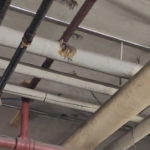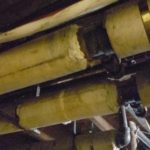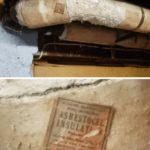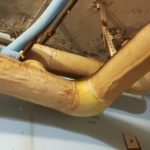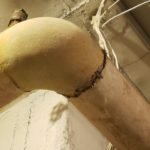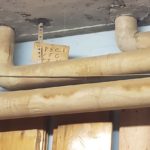Asbestos insulation | Insulation that contains asbestos
What is Asbestos insulation ?
There are a few types of asbestos insulation. Asbestos fibers used for asbestos insulation are known as chrysotile asbestos or white asbestos. Exposure to chrysotile asbestos can cause serious health problems, so removal of asbestos insulation should be carried out under controlled conditions by a professional asbestos abatement contractor. Several different types of asbestos insulation work well, but asbestos cement is ideal because of its durability and resistance to chemical corrosion.
It requires special asbestos abatement techniques to avoid the release of asbestos fibers, as asbestos insulation can be easily damaged during work or when removing nearby asbestos-containing materials.
Asbestos insulation must be removed in small pieces using the wet method because the asbestos material cannot be cut without releasing asbestos fibers.
Decontamination service
- Asbestos at home
- Asbestos insulation
- Asbestos panel
- Asbestos ceiling
- Asbestos in walls
- Asbestos in floors
Types of asbestos insulation
Asbestos insulation refers to insulation materials that contain asbestos fibers. Asbestos is a naturally occurring mineral that was widely used in various industries for its fire-resistant and insulating properties. Asbestos insulation was commonly used in buildings for thermal and acoustic insulation due to its ability to resist heat, fire, and sound.
There are different types of asbestos insulation materials, and they were often used in various forms, such as:
Asbestos Blankets: These were used for insulating pipes, boilers, and other equipment. Asbestos blankets provided thermal insulation.
Asbestos Board: Asbestos-containing boards were used for fireproofing and insulation in construction. They were often used in walls and ceilings.
Spray-Applied Asbestos: Asbestos-containing materials were sometimes sprayed onto surfaces as insulation. This method was used to insulate steel beams and other structural elements.
Asbestos Pipe Insulation: Asbestos-containing materials were commonly used to insulate pipes in buildings. These materials were durable and resistant to heat.
It’s important to note that while asbestos insulation was once widely used, its use has significantly decreased due to the well-documented health risks associated with asbestos exposure. Inhalation of asbestos fibers can lead to serious health issues, including lung cancer, asbestosis, and mesothelioma. As a result, many countries have banned or heavily regulated the use of asbestos, and efforts have been made to remove or encapsulate asbestos-containing materials in buildings to minimize the risk of exposure.
Asbestos insulation has been used as the primary means of insulating homes and other buildings for many years. However, asbestos is a serious health threat, and asbestos materials should not be handled without proper safety equipment and training. It is important to know the types of asbestos insulation so that you can proceed with asbestos removal if necessary or to avoid the risk of experiencing health problems associated with asbestos.
Asbestos insulation was used in homes and buildings because it is made from natural minerals found all over the world. It is inexpensive, resistant to fire, water damage and most chemicals.
The most common form of asbestos insulation was asbestos-cement (A/C) board. The A/C was made by spraying asbestos fibers onto both sides of a cement board core which was then waterproofed with a chemical coating to complement the asbestos insulation board.
Asbestos insulation is used on ships, buildings and vehicles to protect them from fire. It does this by preventing the spread of flames and reducing the oxygen content of the area where it is located. There are three types and these asbestos insulations are:
1. Corrugated asbestos
2. Flexible asbestos and
3. Rigid asbestos
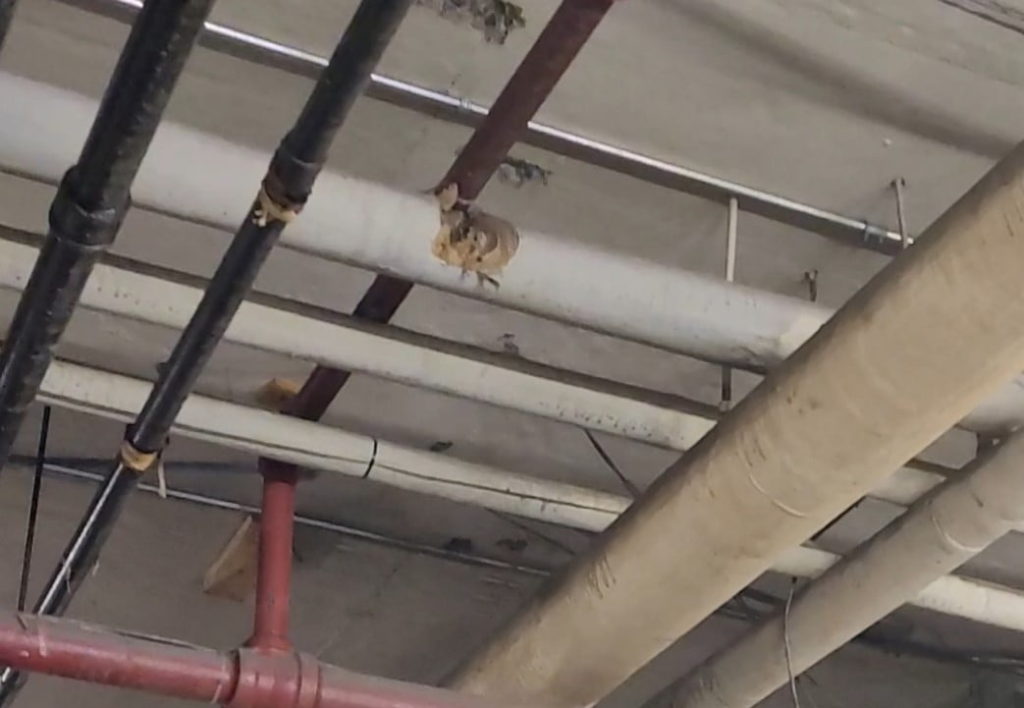
Asbestos has been used in various types of insulating materials due to its thermal and flame retardant properties. Some of the types of asbestos-containing insulation include:
- Thermal insulation: Asbestos has been frequently used in thermal insulation materials such as asbestos boards, asbestos blocks and sprayed insulation. These materials were commonly used in walls, ceilings and floors to improve the thermal properties of buildings.
- Sound insulation: Asbestos has also been used in some sound insulation materials to reduce the transmission of sound through walls and floors. Products such as asbestos boards and sound insulation sprays containing asbestos have been used for this purpose.
- Fire-Retardant Insulation: Due to its resistance to fire, asbestos has been incorporated into fire-resistant insulation materials, such as fabrics, coverings and coatings. These materials were used to protect structures against fire.
Electrical insulation: Asbestos has been added to some electrical insulating materials to improve their insulating properties. These materials were used in electrical cables and other electrical components.
Corrugated asbestos – has been widely used on ships to line engine rooms, boiler walls and superstructures such as decks, bulkheads and cabins since the 1930s. Ships are still fitted with asbestos insulation due to asbestos’ ability to resist heat, fire and corrosion.
Soft Asbestos – Was used on ships as a gasket for boiler covers, as packing around pump handles, valves, flanges and gaskets. It is also found in fire doors on ships that must withstand high temperatures.
Rigid asbestos – Was primarily used on ships as insulation for steam and hot water piping. It was also used in some marine engines, primarily to insulate the engine room from exhaust heat. Soft asbestos was applied to the engine room hatches so that they could be opened if it got too hot.
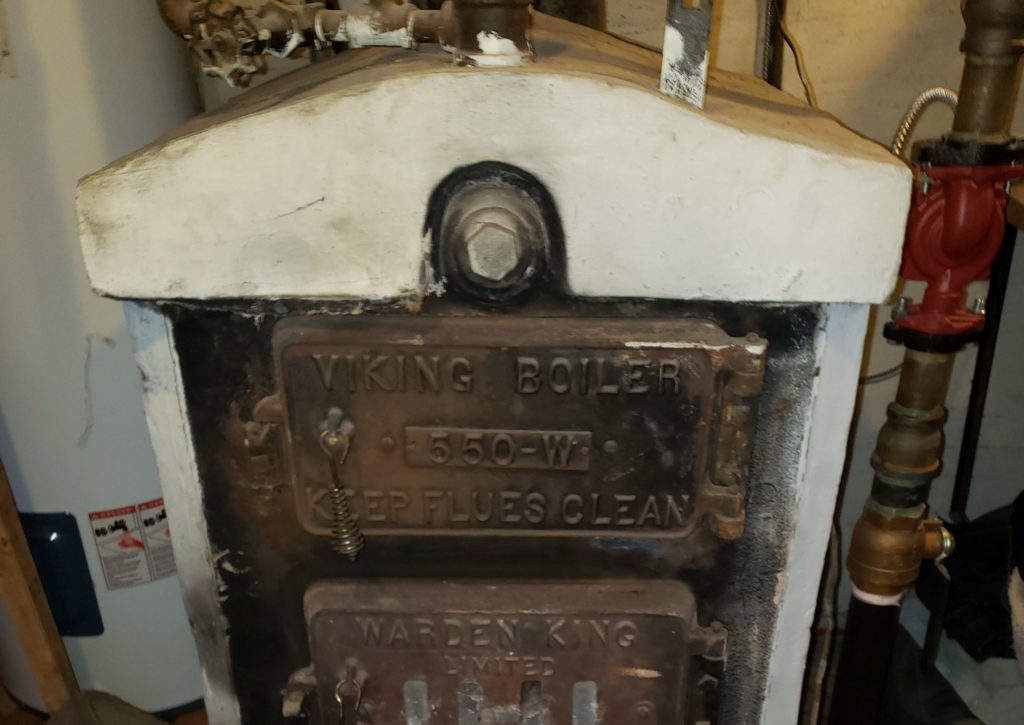
Asbestos insulation for homes and buildings
Asbestos insulation and its use in homes
Asbestos is a strong, bulky mineral fiber that exists naturally. It was used in the past because it is heat and fire resistant and has good sound absorption properties. However, asbestos has been classified as a carcinogen by the World Health Organization (WHO). It is now banned in many countries. It can cause asbestos-related diseases, including asbestos-related lung cancer and mesothelioma.
Asbestos was used in the past to insulate homes. Homes built before the mid-1980s typically have asbestos insulation. However, asbestos insulation has not been used in the construction of new homes since 1977. Some asbestos materials are found in older buildings and homes today, which require special attention if they are removed or disturbed.
Most asbestos insulation used in homes consisted of asbestos-cement sheets covered with a textile finish. Particular care should be taken when working with asbestos insulation or asbestos materials because asbestos fibers can be released into the air and inhaled. Asbestos insulation may also contain asbestos paper, asbestos cardboard, and asbestos shingles.
Asbestos-based insulation does not present a significant risk if it is in good condition and not disturbed. However, asbestos materials that are crumbled, thinned, or damaged can release asbestos fibers into the air.
When asbestos insulation deteriorates, it is advisable not to touch the asbestos materials.
Instead of removing asbestos insulation, homeowners can seal cracks between walls and other places where the asbestos insulation might be damaged with an adhesive caulking compound. Asbestos paper used for bonding drywall can be covered or patched with non-asbestos materials. Asbestos cement insulation boards may be covered with a non-asbestos material or a non-asbestos substitute, such as glass wool insulation.
Asbestos shingles and boards should not be removed unless they pose a risk of releasing asbestos fibers into the air. Asbestos shingles must be sealed before being removed to ensure that no fibers leak into the air.
Asbestos insulation is therefore not dangerous if it is in good condition and is not disturbed. However, asbestos materials that have crumbled, thinned or damaged can release asbestos fibers into the air. When asbestos insulation deteriorates, it should not be handled by owners or tenants.
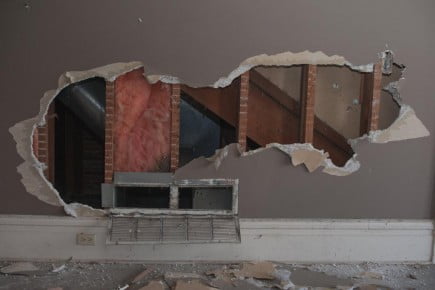
Asbestos wall insulation
Asbestos wall insulation is a material found in homes built before the 1980s. It has been used as an effective insulator and for soundproofing.
Unfortunately, asbestos, as a component of asbestos wall insulation, can cause asbestos-related illnesses.
Today, asbestos is used more sparingly in building materials and only when the risk from asbestos fibers is low. Asbestos used before the 1980s had a very high fiber content and its use was banned in most countries around the world.
Asbestos wall insulation may carry a risk of asbestos exposure which increases with deterioration of the material, disruption during renovations and construction works in nearby asbestos contaminated areas. Once damaged, asbestos wall insulation is no longer effective for soundproofing and becomes a safety risk.
If you suspect the presence of asbestos in your wall insulation, it is important to take appropriate steps to assess and treat the situation. Here are some recommended steps:
- Have asbestos testing done: Hire qualified professionals to perform material testing to determine if asbestos is present in your wall insulation. These tests may involve taking samples which will then be analyzed in the laboratory.
- Consult Asbestos Management Experts: If testing confirms the presence of asbestos, consult professionals specializing in asbestos management to develop an appropriate action plan. This may include asbestos abatement or containment measures, depending on the local situation and regulations.
- Comply with local regulations: Be sure to follow local regulations and guidelines for asbestos management. This may include specific protocols for asbestos removal, as well as procedures for reporting to the relevant authorities.
- Take protective measures: If decontamination work is undertaken, ensure that appropriate protective measures are in place to prevent the release of asbestos fibers into the air. This may include the use of physical barriers, containment systems, and personal protective equipment.
Handling asbestos must be carried out with extreme caution to protect the health of those involved in the work and to avoid the dispersion of asbestos fibers into the environment.
Asbestos ceiling insulation | asbestos roof insulation
Asbestos found in asbestos ceilings, asbestos wall panels and asbestos roof insulation was so prevalent in the 1940s to 1970s that it can be classified as one of the greatest health disasters Americans of all time.
At this time, asbestos became one of the most commonly used materials in building construction, particularly for insulation purposes. Its potential health risks were not fully understood at the time or were ignored by many asbestos manufacturers and distributors.
The first asbestos ceiling tiles went on sale in 1904. By 1944, homeowners could obtain asbestos roofing through asbestos cement manufacturers such as Manville Corporation.
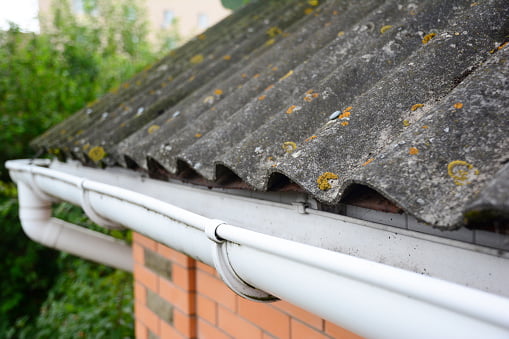
In the early 1940s, asbestos roofing was still a relatively new product and asbestos ceiling tiles were also growing in popularity. The asbestos industry was thriving, and asbestos manufacturers believed that if homeowners had easy access to their products, asbestos would continue to be used on a large scale for insulation. To make asbestos products more attractive to consumers, asbestos manufacturers began offering asbestos ceiling tiles and roof insulation in a variety of bright colors.
In the early 1950s, asbestos ceiling manufacturers increased their advertising efforts to target women. A Johns Manville ad even showed a pregnant woman standing in her asbestos kitchen with the caption: “A Healthy Baby Starts with a Healthy Mother.” Additionally, asbestos manufacturers distributed pamphlets in asbestos offices. county and medical societies regarding asbestos. They urged doctors to tell expectant mothers that asbestos insulation was the best material for a hygienic home environment.
If asbestos manufacturers had been honest with homeowners about asbestos products, the use of asbestos ceilings and roof insulation may never have been as widespread in the United States.
Asbestos insulation
Lagging is a technical term used to describe the insulation of piping. The insulation may or may not contain asbestos. Asbestos insulation remains insulation, whether it contains asbestos or not.
The risks of exposure to asbestos linked to insulation arise in the event of wear or aging of the material, or during work, which can cause the dispersion of asbestos fibers in the air. Asbestos panels and insulation have been banned from use since the asbestos ban came into effect on December 31, 1993.
However, asbestos insulation or panels can still be found in buildings following renovation work carried out before the ban came into force. Given the health risks linked to asbestos, asbestos removal must always be carried out by a specialized company.
If they are asbestos insulation panels (panels containing asbestos insulation between two layers of asbestos paper) or asbestos insulation (loose asbestos fibers covering metal sheets), they must be removed by a specialist company authorized to remove asbestos.

Spray-On Asbestos Insulation
Spray-on asbestos insulation refers to a type of insulation material that contains asbestos and is applied to surfaces using a spray method. This method was commonly used in the past for insulating various structures, such as steel beams, ceilings, and walls. The spray-on application allowed for a seamless and effective way to provide thermal and acoustic insulation.
The spray-on asbestos insulation typically contained asbestos fibers mixed with other materials such as binders and adhesives. It was known for its fire-resistant properties and ability to resist heat, making it a popular choice in construction and industrial settings.
However, the use of asbestos-containing materials, including spray-on asbestos insulation, has significantly declined due to the well-documented health risks associated with asbestos exposure. Asbestos fibers, when released into the air through deterioration or disturbance of the material, can be inhaled and lead to serious health issues such as lung cancer, asbestosis, and mesothelioma.
Given the health risks, many countries have implemented regulations to restrict or ban the use of asbestos, and efforts have been made to identify and safely manage existing asbestos-containing materials in buildings. If you suspect that your home or building may contain spray-on asbestos insulation, it is crucial to consult with asbestos professionals for a proper inspection and assessment.
Handling or attempting to remove asbestos-containing materials without proper precautions and expertise can result in the release of asbestos fibers, creating a hazardous situation. Professionals can conduct testing, assess the condition of the material, and recommend appropriate measures such as encapsulation, enclosure, or safe removal if necessary. Always prioritize safety and follow local regulations when dealing with asbestos-containing materials.
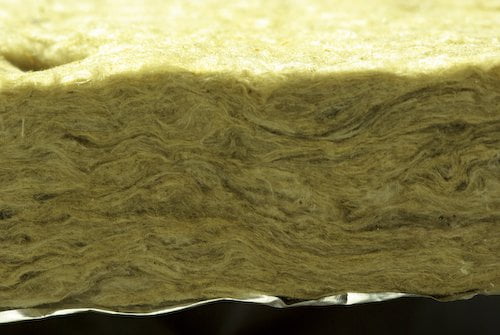
Asbestos wool
Asbestos wool is a form of insulation that has been manufactured by incorporating asbestos into a fibrous matrix, often in the form of long, thin fibers. Asbestos has been used in the manufacture of many products, including insulation, due to its thermal, flame retardant and corrosion resistant properties.
Among the fibrous materials used to insulate houses, we find rock wool and glass wool (asbestos wool). Even if asbestos is banned today, we must think about the past and take all the usual precautions. These materials are composed of fibers which, due to their small size, can be inhaled. The case of fiber cement must be considered separately. In this case, the asbestos is fixed in the cement.
These insulators are found mainly in attics, attics, roofs, double wall partitions and false ceilings.
Why Is Asbestos Insulation Dangerous?
Asbestos insulation is dangerous due to the health risks associated with exposure to asbestos fibers. When asbestos-containing materials are disturbed or damaged, they can release microscopic fibers into the air. Inhalation of these fibers poses a significant health risk, as they can become lodged in the lungs and other tissues, leading to serious and sometimes fatal health conditions. Here are some reasons why asbestos insulation is considered dangerous:
Respiratory Health Risks: Inhalation of asbestos fibers can cause a range of respiratory problems. The fibers are small and durable, and once inhaled, they may remain in the lungs for long periods. This can lead to conditions such as asbestosis, a chronic lung disease characterized by scarring of the lung tissue, and pleural plaques, which are areas of scar tissue on the lining of the lungs.
Lung Cancer: Long-term exposure to asbestos increases the risk of developing lung cancer. Asbestos is a known carcinogen, and the risk of lung cancer is particularly high among individuals who have been exposed to asbestos fibers over an extended period, such as asbestos miners, construction workers, and individuals living in homes with asbestos-containing materials.
Mesothelioma: Mesothelioma is a rare and aggressive form of cancer that is almost exclusively linked to asbestos exposure. It affects the lining of the lungs, abdomen, or heart. Mesothelioma has a long latency period, often taking decades to develop after exposure to asbestos.
Other Cancers: In addition to lung cancer and mesothelioma, asbestos exposure has been linked to other cancers, including cancers of the larynx, ovaries, and asbestosis.
No Safe Level of Exposure: Unlike some substances where a certain threshold must be reached to cause harm, there is no safe level of asbestos exposure. Even minimal exposure to asbestos fibers can potentially lead to health issues, and the risk increases with the duration and intensity of exposure.
Due to the serious health risks associated with asbestos, its use has been largely discontinued in many countries, and regulations are in place to control its handling, removal, and disposal. If asbestos-containing materials are present in a building, it is essential to take proper precautions, and removal or encapsulation should be performed by trained professionals to minimize the risk of fiber release and exposure.
How to test for asbestos insulation ?
Testing for asbestos insulation should be conducted by trained and accredited professionals to ensure accuracy and safety. Here are the general steps involved in testing for asbestos insulation:
Hire a Licensed Asbestos Inspector: Look for qualified and accredited asbestos inspectors or testing laboratories. Ensure that they have the necessary certifications to perform asbestos testing.
Site Inspection: The asbestos inspector will visit the site to assess potential asbestos-containing materials. They will identify areas where asbestos insulation may be present, such as in pipes, ducts, insulation materials, or other building components.
Sample Collection: The inspector will take samples of suspected asbestos-containing materials. This is typically done by carefully collecting small samples without causing damage or releasing fibers into the air.

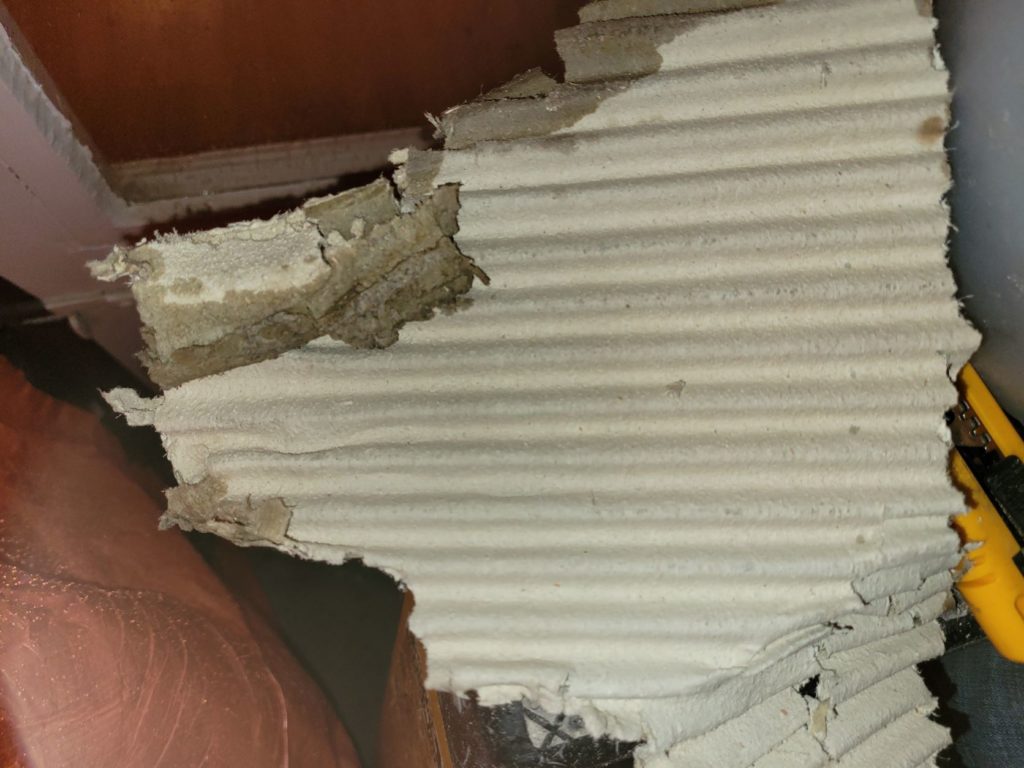
-
Analysis in a Certified Laboratory: The collected samples are sent to a certified asbestos testing laboratory. Trained professionals use specialized equipment and techniques to analyze the samples for the presence of asbestos fibers.
-
Reporting: The laboratory will provide a detailed report on the asbestos content in the samples. This report will indicate whether asbestos is present, the type of asbestos identified, and the concentration of asbestos fibers in the material.
-
Interpretation and Recommendations: Based on the test results, the asbestos inspector will interpret the findings and provide recommendations. This may include options for managing or removing asbestos-containing materials, depending on the condition and location of the materials.
It’s important to note that asbestos testing and removal should be performed by professionals with the expertise and equipment to handle asbestos safely. DIY testing is not recommended, as improper handling of asbestos-containing materials can lead to fiber release and pose serious health risks.
If you suspect asbestos insulation in your home or building, it’s crucial to contact licensed asbestos professionals who can assess the situation, conduct proper testing, and recommend appropriate actions to address any asbestos-related concerns. Always prioritize safety and follow local regulations regarding asbestos testing and abatement.
Conclusion
In conclusion, understanding the implications of asbestos insulation is crucial for the safety of your home and loved ones. As we’ve explored the risks associated with asbestos exposure and the importance of proper management, it’s clear that informed decisions are key. Whether considering removal, encapsulation, or preventive measures, prioritizing safety is paramount. Stay vigilant, seek professional guidance, and create a home environment that promotes health and well-being. Together, we can ensure a safer and asbestos-free living space for generations to come.

